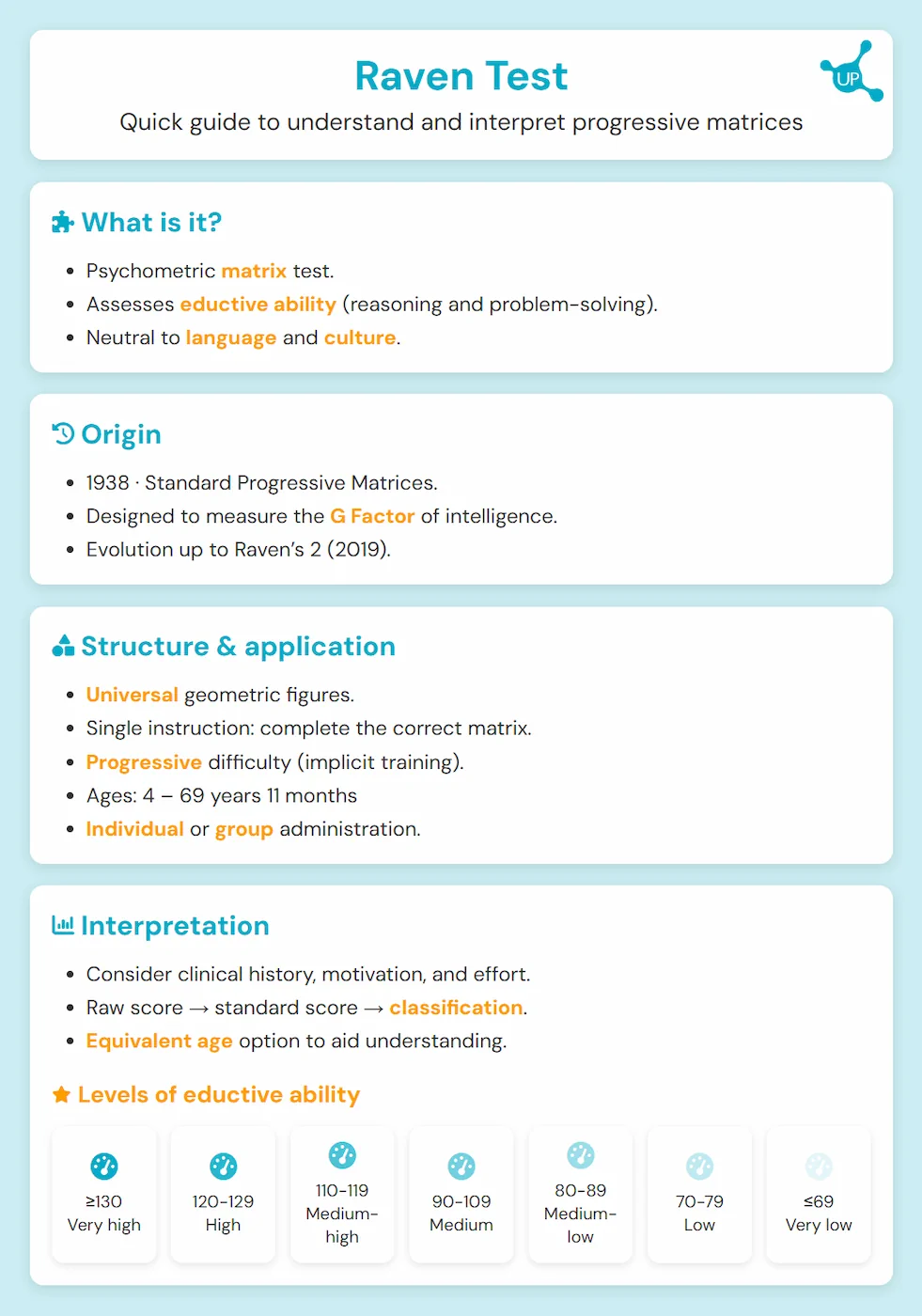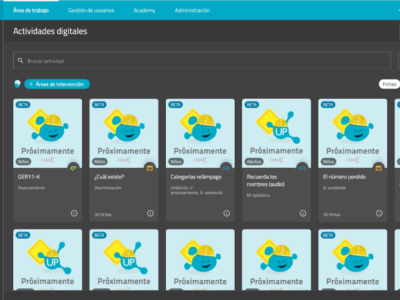In this article clinical neuropsychologist and Director of Espai Neurològic, Anna Curto, explains what the Raven test consists of and how to interpret the results of the Raven’s Progressive Matrices test.
What is the Raven test and what does it measure?
If you wonder what the Raven test is and what it is for, the Raven test is a psychometric assessment that consists of completing the matrices presented by choosing from several available options.
With this seemingly simple task the eductive ability of the test-taker is evaluated, thus obtaining a score of the person’s ability to reason and solve complex problems.

Origin of the test
This test has gone through several names and versions; the first dates back to 1938 when it was published under the name Raven’s Standard Progressive Matrices. The idea has not varied across its different versions, but it has been revised and adapted to different populations. The latest version published is Raven’s 2 and dates from 2019.
The Raven matrices were designed to assess the “G factor” of intelligence, which is estimated as the ability to solve complex problems through intellectual reasoning without language interference and therefore without influence from the person’s prior educational and cultural level.
What does the Raven test involve?
As specified in the Raven’s 2 manual in its latest version, the test consists of a series of universal and identifiable geometric shapes regardless of educational level. The verbal instruction is unique and does not require any writing or speaking ability for correct completion, since it simply consists of completing the presented matrix with one of the elements or patterns shown among the different available responses.
Raven test: age range
Furthermore, the age range in which it can be administered is very broad; from 4 years up to 69 years and 11 months.
This test measures what Spearman (1927) called eductive ability. Eductive mental activity requires making sense of disorder, searching for what is not obvious and also probing new perceptions. In short, it would be equivalent to analyzing the pattern of relationships of the presented stimuli, looking for what changes or relationships exist between them and from there determining which would be the correct response from those presented.
These tasks are presented with progressive difficulty, which allows the test-taker to train in the resolution method.
How to administer the Raven test? Main uses
The score obtained on the Raven test cannot be interpreted as the value of the subject’s overall intelligence, since it only assesses specific domains of cognitive functioning.
These domains are closely related to executive functions (reasoning, planning, cognitive flexibility, decision making, abstraction…), and it is not recommended to administer it to people for whom these domains are particular strengths or weaknesses, due to bias in the results that can be obtained.
It can be administered individually or in groups, which gives it versatility, being useful to assess eductive ability in groups (scientific research, educational centers, staff selection processes, etc.) as well as in individual assessments such as cognitive and/or psychological assessment centers.
Clinical practice
In clinical practice, when we intend to assess a person’s global intelligence it is more appropriate to use other intelligence test batteries, such as Weschler (WPPSI, WISC or WAIS) in their different versions since they provide a more global approximation of cognition.
Specifically, Weschler’s intelligence tests include a subtest in the domain of perceptual reasoning or fluid reasoning that is precisely based on the Raven’s Progressive Matrices. This is because the eductive capacity assessed by the Raven test is very similar to what is known as fluid intelligence, which is defined as the ability to solve problems, to reason and to think flexibly.
Patients with acquired brain injury with language impairments
On the other hand, the Raven Matrices are very useful in estimating the abilities of those patients who cannot use language, whether due to a disorder, an injury or simply because they do not know it. This facilitates, for example, estimating the eductive ability in patients with acquired brain injury who have lost the use of language, with the aim of determining, for example, their premorbid cognitive level and thus being able to formulate more realistic stimulation and/or rehabilitation objectives.
It is also easy to administer to people with a language disorder, such as TDL, or others such as selective mutism or foreigners who do not know or master the language.
How to interpret the Raven test? Interpretation of Raven test results
The results obtained on the Raven’s Progressive Matrices test must be interpreted taking into account the patient’s medical, personal, occupational and emotional history, as well as their degree of motivation and effort during the administration of the test.
Raw scores are the correct answers obtained directly on the test, and these are finally transformed into standard scores that allow us to qualitatively classify the subject’s eductive ability.
| Standard score | Qualitative classification |
|---|---|
| ≥ 130 | Very high |
| 120-129 | High |
| 110-119 | High-average |
| 90-109 | Average |
| 80-89 | Low-average |
| 70-79 | Low |
| ≤ 69 | Very low |
In addition, there is also the possibility of checking the age-equivalent, which shows the average age, in years and months, at which a given aptitude score is most frequently obtained. This helps the interpretation and understanding of scores and equivalents for people who do not have general knowledge of psychometric concepts.

Conclusion
The Raven test, also known as Raven’s Progressive Matrices, is a psychometric test with a long history in psychology that is capable of estimating the eductive ability of the person who responds to it.
It uses basic and universal geometric shapes, understandable for all ages and cultures. It is mainly based on the capacity for intellectual reasoning, of making sense of disorder and without interference from language and/or culture.
It is a very versatile test, both for its administration, which can be group or individual, as well as for the age range it can assess, covering from 4 years to 69 years and 11 months.
Frequently asked questions about the Raven test
1. What is the Raven test and what does it measure?
Psychometric progressive matrices test that assesses eductive ability or fluid reasoning. It measures the capacity to detect patterns and solve problems without influence from language, culture or schooling, offering an estimate of the g factor of intelligence.
2. What does the Raven’s Progressive Matrices test involve?
It consists of completing the missing piece in a matrix of figures, choosing from several options. The instruction is simple, does not require reading or writing and the difficulty progresses by blocks. It can be administered individually or in groups.
3. What ages does the Raven test cover?
It is administered from 4 years to 69 years and 11 months, making it suitable for multiple cultures and educational levels.
4. What is the Raven test used for?
It is used to estimate fluid reasoning or eductive ability in educational, clinical, research and personnel selection contexts. It is useful when language limits evaluation. It does not replace global intelligence batteries like Wechsler’s Number Lines.
5. How to interpret the Raven test results and percentiles?
Correct answers are transformed into standard scores and percentiles, classifying from very low to very high. Interpretation must consider medical and personal history, motivation and effort. Age-equivalent can be consulted to facilitate understanding.
6. What differentiates the Raven test from Wechsler’s Number Lines?
The Raven test assesses nonverbal reasoning through matrices and offers a specific estimate of the g factor. Wechsler’s Number Lines provide a global IQ and include perceptual reasoning subtests inspired by Raven.
References
- Pearson (2019). Raven’s 2 Manual, progressive matrices.
If you liked this article about the Raven test, you may also be interested in these blog posts:
“This article has been translated. Link to the original article in Spanish:”
Test de Raven: Qué es y cómo interpretar el test de matrices progresivas de Raven







 Activity to Associate Phoneme with Grapheme: Letter Detective
Activity to Associate Phoneme with Grapheme: Letter Detective
Leave a Reply